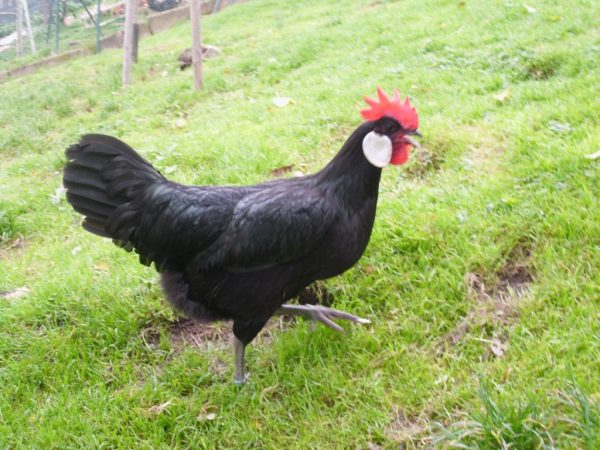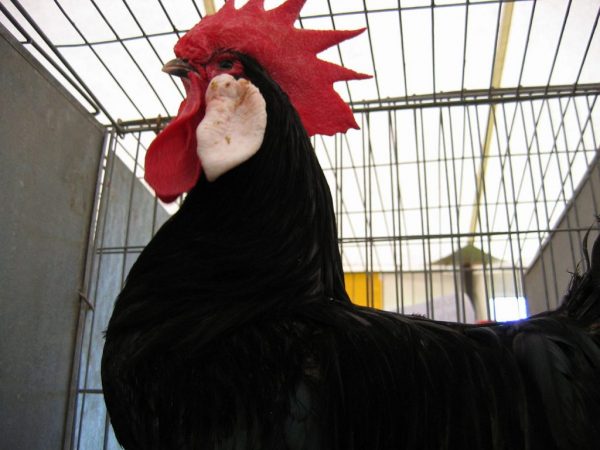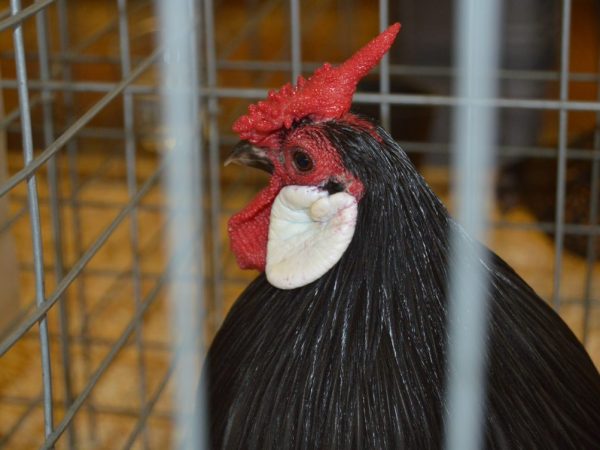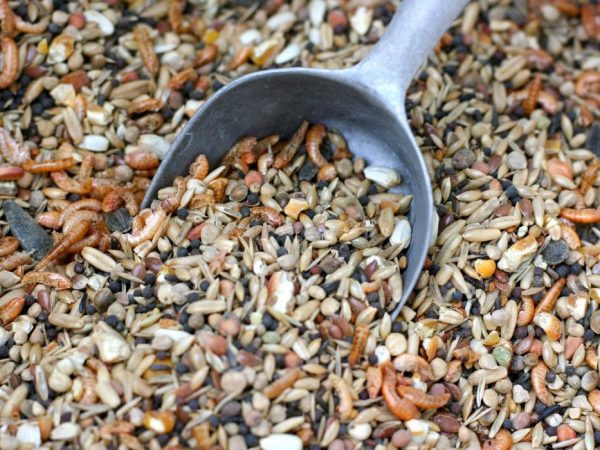Minorca hens
The Spanish breed of Minorca chickens was bred on the small island of Minorca. Later this breed was brought to Europe, it came to Russia thanks to the Turkish khan. An elegant bird with beautiful decorative features, it has good productivity indicators. In order not to violate these qualities, breeders decided to exclude interference with genetics.

Minorca hens
a brief description of
- Productivity type: egg and meat direction.
- Rooster weight: the average weight of a male with black plumage is 3 kg, a white rooster is 3.4-4 kg, a dwarf rooster is 1 kg.
- Chicken weight: a female with black plumage weighs 2.5 kg, with a white one - 2.7-3.6 kg, in a dwarf one - 800 g.
- Ovipositor start: early (at five months).
- Egg production: excellent egg production in the first year of life is 160-170, the second year is slightly lower - 140, in a dwarf breed up to 120 eggs.
- Features of the: do not tolerate cold and sudden changes in temperature.
- The size: the mass of eggs in young animals is 60 g, in adult layers - 70-80 g, in dwarf ones - 35-40 g.
- Are they suitable for a beginner: Yes.
Description of the breed
There are three main lines of this breed, each of which has distinctive characteristics.
Black
The Spanish black Minorca has a small, regular head with a red scallop divided into several segments.
In females, it hangs to one side, in males it is erect. The earrings are red, the lobes are white. The beak is black in females, and in roosters it is white at the tip. The plumage is beautiful - black with a greenish tint.
The neck is elongated, the eyes are like buttons - resinous or dark brown. The chest is rounded, the body is long, the wings are well developed. Legs are stocky, strong, high, yellow. The nails are black. The average weight of a male is 3 kg, of a female - 2.5 kg.
White british
White minorks of impressive size - males from 3.4 to 4 kg, chickens - 2.7-3.6 kg.
The description of the breed includes:
- beak, claws and metatarsals are light pink;
- reddish eyes;
- the crest is foliate, rounded, well developed;
- plumage is white with a silvery tint.
Dwarf
This bird was bred as a result of the experimental work of German breeders. Chickens are miniature - the average weight is 800 g, for cockerels - 1 kg.
Character
Chickens of the Minorca breed have a peaceful and unassuming character, so they can be safely kept in a herd with representatives of other lines.
Roosters also treat young animals, owners and chickens of a different color favorably, without showing aggression and impulsiveness.
The cost
This breed can be purchased at the Federal State Unitary Enterprise Gene Fund of the Russian Agricultural Academy. Depending on the season, the price of a hatching egg varies from 40 to 60 rubles.
Experienced breeders advise buying two-week-old young animals from private farms after a careful examination of each individual. The cost is from 250 to 450 rubles per chicken.
Productivity indicators

The breed has good egg production
Large meat yield from an adult on average from 3 to 3.5 kg.
Excellent egg production in the first year of life: whites and blacks give 160-170 eggs, in the second year a little less - 140 eggs, dwarf eggs - up to 120 eggs.
The size of the eggs in pullets is 60 g, in two-year-old layers - 70-80 g, in dwarf ones - 35-40 g.
Culling hens
The selection of young animals for further breeding and egg production is selected at a young age, based on the general condition of the chicks, then at the age of 5 months, taking into account the egg production.
The quality of males is determined by the appearance of the ridge and conformation.
Advantages and disadvantages
The Minoroc has many advantages that set it apart from other breeds:
- good indicators of meat and egg productivity;
- chicks have good survival rate (about 95%) and fast growth;
- taste of eggs and meat at the highest level;
- birds are peaceful;
- early maturity - the first eggs begin to lay in the fifth month of life.
Among the disadvantages there are several nuances - they do not tolerate temperature changes, they get cold in dampness and cold.
The second minus is that the chickens are very shy, react negatively to the stresses associated with moving to another room or a sharp change in the microclimate, light day, up to the cessation of egg production.
These birds have a weak incubation instinct, so they breed them using an incubator.
Breeding features
To obtain strong and healthy offspring, eggs are taken from pullets that lay in the second year. Take medium-sized specimens with an even and smooth shell, without cracks. You do not need to wash them before placing them in the incubator.
The optimum age for eggs is 5-6 days. Not too pointed or rounded will do. they produce underdeveloped chickens with various pathologies and defects.
The prepared material is closed in an incubator and the temperature is set to 40 ° C. After a week, it is lowered by 1 ° C, then by that much after seven days.
Chicks begin to hatch 20-21 days after laying the eggs. During this period, they must be turned over regularly to ensure uniform heating.
Care
In the first three weeks, it is important to ensure that the chicks are kept in optimal conditions at home:
- they are moved into a cardboard or wooden box with a bedding, a lamp with infrared rays is installed on top at a distance of 0.5 m, providing illumination for at least 22 hours a day;
- stable heat within 30 ° С, then daily the temperature is lowered by 3-4 ° С, stopping at around 18-19 ° С;
- after 14 days, the chickens can be taken out into the fresh air - walking under the sun 1-2 hours a day will only benefit them;
- at 1.5 months old young growth is transferred to a common herd.
After hatching, the Minorca chicks grow rapidly, fledge, are agile and have good adaptive abilities.
Feeding

Birds need to be cared for properly
On the first day, the chickens are soldered with a glucose solution - 50 g are diluted in a liter of water. Then they give clean and fresh water at room temperature.
As soon as the fluff dries up on the chicks and they become active, they are offered the first food - a finely chopped boiled egg.
The next day, it is mixed with chopped green onions. Starting from a week of age, you can give small cereals, low-fat cottage cheese.
After 20 days, finely chopped greens are given - dandelion, nettle, plantain and clover. The herb contributes to the full functioning of the digestive system.
At the age of one month, they are fed with mash of boiled, grated vegetables, root vegetables and fruits. They also offer bran and yeast, meat and bone meal and vitamins.
At 1.5 months old young animals can be completely transferred to the diet of adult birds.
Features of keeping adult chickens
One of the most remarkable qualities of this breed is its beautiful crest.
It often happens that in cold and frosty conditions this decoration loses its decorative effect - it freezes and dies off.
To prevent this, the birds should be provided with proper conditions in winter.
House requirements
The room should be spacious, without drafts and crevices through which rats can get through, mice are the main carriers of various infections.
The optimal area for one individual is 50-60 m³.
The poultry house is cleaned of debris, the walls and the floor surface are treated with slaked lime or a solution of colloidal sulfur (2% concentration). The floor is sewn up with tin or planks, then dry flooring is laid - sawdust, straw or hay.
The ideal thickness in the winter season is 40-50 cm. Perches are installed at a height that is comfortable for birds - 0.5-0.6 m. In secluded places, nests (boxes or boxes) are placed at the rate of 3 layers 1 nest.
Containers for food and water are placed on the floor. If the herd is large, you will need several feeders and drinkers. For convenience, many breeders use nipple or groove designs to keep the water cleaner and fresher longer. A basin with dry clay or ash is placed in the middle. Regular dry bathing prevents the appearance of various parasites in chickens.
The optimum temperature in the hen house should not fall below 20 ° С in winter, in summer - 12-13 ° С. Ventilation is provided by daily ventilation through a window or door.
Lamps with subdued blue light are suitable as lighting - such lighting has a calming effect and has a beneficial effect on egg production.
Feeding
The basis of the diet of adult birds is a compound feed already prepared or prepared independently.
The following ingredients must be mixed:
- meat and bone or fish meal;
- sunflower meal;
- minerals;
- shredded wheat or barley.
The optimal proportions are 1: 3: 1: 4. They feed at the rate of one individual - 130 g.

You can prepare the compound feed yourself
In winter, they feed them with mash of boiled vegetables and fruits. Greens are replaced with herbal flour. To compensate for the lack of calcium, pieces of chalk and shell rock are placed in separate feeders. Fish oil is added to dry food.
In summer, chickens feed on compound feed, fresh grass, insects, gravel, and shellfish. Additionally, during this period, they are given grated fruits, raw vegetables.
A container with sand is placed in the chicken coop - birds eat this component with great pleasure. It helps prevent blockage of the goiter and the development of various diseases. In winter, a warm drink at room temperature is poured; in summer, drinkers are filled with cold water. Fluid change is carried out daily.
Walking place
In the absence of a place for walking, the birds are fed less fatty food - they increase the amount of vegetables, fruits, greens and reduce the rate of compound feed, since due to low mobility, the hens begin to grow fat and rush poorly.
If the area allows, the yard is fenced with a net or slate with a height of 1.5 m. It is not necessary to cover the top, since these birds have a large mass and poor flying abilities, with the exception of dwarf Minorocs.
The place is sown with grain or field grasses to provide the livestock with fresh greens in summer. The site is sprinkled with shells, gravel, chalk.
In the winter season, a shelter with perches can be made in the walking yard. So chickens and cockerels will be able to walk in the off-season, pecking at the snow and food under its cover.
Possible diseases
These birds are very susceptible to cold, as a result of which they begin to get sick with colds. Signs are nasal mucus, fever, rapid breathing, refusal to feed, and a high need to drink. Treatment is carried out with the drug furazolidone or biomycin.
For the prevention of infectious diseases, it is recommended to vaccinate chickens at an early age. In addition to this, you must comply with the sanitary and hygienic standards of maintenance:
- regularly change the litter - at least once a year;
- remove the remains of feed every day and change the contaminated water to fresh;
- provide a stable temperature regime and illumination;
- avoid crowding of chickens, which leads to a violation of the microclimate and the appearance of parasites;
- regularly inspect the herd and quarantine sick individuals.
Breeder reviews
Many breeders choose the Minorca breed primarily because of the high decorative features of chickens.
Others appreciate the palatability of the meat and the quick ability to build mass, as well as the good survival rate of the chicks.
Some poultry farmers were bribed by the calm nature of the birds, which can be safely kept in the same courtyard with representatives of other lines, which is very convenient in small private farms.
According to farmers, keeping in harsh climatic conditions is problematic - the ridge freezes, dies off, so it often needs to be greased. Ideally, the Minorca is suitable for breeding in the southern zone.


